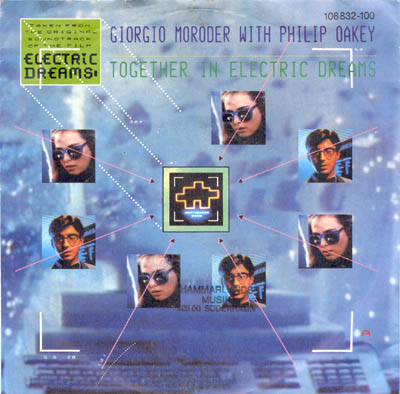- Together in Electric Dreams
Single infobox |
Name = Together in Electric Dreams

Artist =Giorgio Moroder andPhilip Oakey
from Album =Philip Oakey & Giorgio Moroder and Electric Dreams soundtrack
Released =1984
Format = Single
Recorded = 1984
Genre =Synthpop Electronica
Length = 3:45
Label =Virgin Records
Producer =Giorgio Moroder
Last single = -
This single = "Together in Electric Dreams" (1984)
Next single = "Good-Bye Bad Times " (1985)"Together in Electric Dreams" is a song by the British singer and composer
Philip Oakey and producerGiorgio Moroder . It was written by Oakey and Moroder and recorded for the original soundtrack of the 1984 film "Electric Dreams".It later formed part of the joint album "
Philip Oakey & Giorgio Moroder ", released in 1985. Released as a single in the UK in September 1984 it proved a major commercial success, actually eclipsing the original film it was intended to promote. It reached Number three in theUK Singles Chart , staying in the charts for 13 weeks. It would prove to be the only hit of the brief Oakey/Moroder partnership. It was finally released as a single in theUnited States in 1988.Background
The film "Electric Dreams" was to be director
Steve Barron 's first full feature film. Previously Barron had made a name for himself conceiving and directing a number of innovative music videos during the early 1980s. His biggest success had been directing the music video forThe Human League 's "Don't You Want Me " in 1981 which helped the single become number one in the UK and U.S.For the film "Electric Dreams" Barron wanted to emulate the huge success of the film "
Flashdance " a year earlier. "Flashdance" had used the electronic music of Giorgio Moroder, so Barron enlisted Moroder as director of music, who wrote most of the score. Barron wanted the end credits to roll to "an emotional" song in the same way as "Flashdance" had done.Moroder wrote "Together in Electric Dreams" which was to be a male solo vocal, when he asked who Barron would like to sing the lyrics, Barron immediately thought of his former associate Philip Oakey.
When Oakey recorded the song it was over very quickly, after the first full recording Moroder told Oakey that the first take was "good enough, as first time is always best". Oakey who thought he was just rehearsing insisted on doing another take. Moroder let him but to this day Oakey is convinced that Moroder still used the first take on the final production. Originally released to advertise the film, "Together in Electric Dreams" quickly overshadowed the original film and became a hit single in its own right.
Oakey states that it is ironic that a track that took literally ten minutes to record would become a worldwide hit, while some of his Human League material that took over a year to record didn't. Kolling, Niels [http://www.the-black-hit-of-space.dk/together_in_electric_dreams.htm] ]
Association with The Human League
The Human League are a British
synthpop band of which Philip Oakey is the lead singer and the role for which he is best known, although he has worked on numerous other projects. "Together in Electric Dreams" was released at the height of the Human League's international fame and success. The song style broadly mimics the Human League's traditional sound. Because it was sung by Oakey and was a hit at the same time as the Human League's highest profile, it quickly became closely associated with the band. It would go on to become a bigger hit than some actual Human League singles of the same period. Often it is erroneously credited as a Human League single. Because of its close association with the band and its popularity it was included in their various "Greatest Hits" compilation albums released later.Although the Human League have never recorded their own version, due to the song's popularity the band frequently play a unique Human League version when they perform live, often as an encore. The Human League version differs considerably from the original in that it has a longer more dramatic intro and the female backing vocals by
Susan Ann Sulley andJoanne Catherall are now as prominent as Oakey's lead.Promotional music video
The promotional video was originally designed to promote the film "Electric Dreams" not the song, and this was how most U.S. viewers would see it. In the UK where the original film was a flop the promotional video was perceived to be a music video first, and often erroneously a Human League video.
Like many film soundtrack promos, the video splices key scenes from the film with footage of Philip Oakey. In addition, other promotional scenes were created especially for the video: an "Electric Dreams" signboard is seen behind Oakey twice, the actual movie poster is seen behind him on the freeway and the computer from the film is seen relaxing on the beach. Oakey is seen being driven around purportedly
San Francisco (but was actuallyLos Angeles ) singing the lyrics. The video would famously finish with a sock puppet parody of theMGM Lion on a TV screen, on a beach.Giorgio Moroder himself makes a cameo appearance in the video as the boss of the radio station taken over by the computer.
In the media
* It is played on the fictional radio station Flash FM in the video game "".
References
Wikimedia Foundation. 2010.
